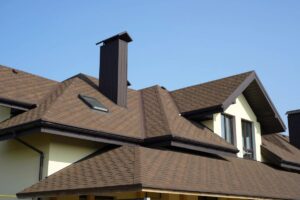How to Maintain Your Asphalt Shingles for Longevity
Asphalt shingles are a popular choice for roofing due to their durability, cost-effectiveness, and aesthetic appeal. When properly maintained, asphalt shingles can last for decades, providing reliable protection for your home. However, like any roofing material, they require regular care and attention to ensure their longevity. This blog post will guide you through the essential steps for maintaining your asphalt shingles and helping them stay in excellent condition for years to come.

Regular Inspections: The Foundation of Good Maintenance
The first and most important step in maintaining asphalt shingles is conducting regular inspections. Ideally, you should inspect your roof at least twice a year—once in the spring and again in the fall. Additionally, after severe weather events such as storms or heavy snowfall, it’s crucial to check your roof for any damage.
When inspecting your roof, look for any signs of wear and tear such as cracked, curling, or missing shingles. These issues can often be resolved quickly if caught early. Pay close attention to areas where shingles meet chimneys, vents, or skylights, as these are prone to leaks if not properly maintained.
Keep Your Roof Clean and Free of Debris
A clean roof is a happy roof. Over time, debris such as leaves, twigs, moss, and algae can accumulate on your asphalt shingles, potentially causing damage. Moss, in particular, can trap moisture and promote the growth of mold, which weakens shingles and can lead to costly repairs. To keep your roof in optimal condition, it’s important to clear away any debris regularly.
When removing debris, use a soft-bristled broom or a blower to avoid damaging the shingles. Avoid using harsh pressure washers, as these can strip the granules from the shingles, leading to premature deterioration. Be cautious when walking on your roof; walking on shingles can cause them to crack or dislodge.
Maintain Proper Ventilation
Good roof ventilation is essential for extending the life of your asphalt shingles. Without proper airflow, heat and moisture can build up in your attic, which can damage the shingles and lead to mold growth or rot in your roof deck. Proper ventilation helps regulate temperature and moisture levels, preventing damage from excessive heat or humidity.
Check your attic periodically to ensure there is adequate ventilation. Look for soffit vents, ridge vents, or gable vents that allow air to flow freely through the attic. If you’re unsure whether your home has proper ventilation, it’s worth consulting with a roofing professional who can evaluate your system and recommend improvements.
Repair Small Issues Immediately
Small issues with your asphalt shingles may seem insignificant, but ignoring them can lead to larger problems down the line. For instance, a single missing or cracked shingle can allow water to seep into your roof and cause rot in the underlying wood. If you notice a problem, address it as soon as possible to avoid more extensive damage.
Many minor repairs can be done by homeowners with the right tools, but it’s important to exercise caution when working on your roof. If you’re not comfortable making repairs yourself, it’s always a good idea to hire a professional roofer to handle the job.
Protect Your Roof from Harsh Weather
 Weather is one of the primary factors that can impact the lifespan of asphalt shingles. In areas prone to extreme heat, cold, or storms, your shingles may face additional stress. While you can’t control the weather, there are steps you can take to protect your roof during severe conditions.
Weather is one of the primary factors that can impact the lifespan of asphalt shingles. In areas prone to extreme heat, cold, or storms, your shingles may face additional stress. While you can’t control the weather, there are steps you can take to protect your roof during severe conditions.
Trim overhanging tree branches to prevent them from scraping or falling onto your roof during windstorms. Keep gutters clean to ensure that water flows off the roof rather than backing up and causing leaks. In areas with heavy snow, it’s important to remove the snow from your roof regularly to prevent ice dams, which can force water under the shingles and cause leaks.
Ensure Proper Installation and Repair
The best way to prolong the life of your asphalt shingles is to ensure they are installed and repaired properly. Poor installation can lead to premature failure, leaving your roof susceptible to leaks and damage. When installing a new roof, make sure you hire a reputable and experienced roofing contractor who follows proper installation techniques.
If your roof has any existing issues, such as damaged or loose shingles, have them repaired by a professional. Correcting problems early on will help prevent more expensive repairs down the road and ensure your shingles continue to protect your home effectively.